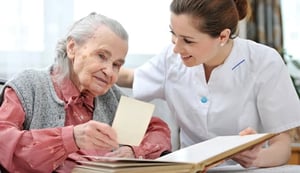 Aphasia is a language disorder resulting from an injury to the brain, such as a stroke or head trauma. Aphasia involves varying degrees of communication difficulties in these areas:
Aphasia is a language disorder resulting from an injury to the brain, such as a stroke or head trauma. Aphasia involves varying degrees of communication difficulties in these areas:
Spoken Language Comprehension - otherwise known as “Receptive Language” or “Auditory Comprehension.”
Symptoms may include:
- having trouble understanding what someone is saying
- needing extra time to understand what is said
- providing unreliable answers to “yes/no” questions
- difficulty understanding longer sentences and conversation
- finding it challenging to follow fast speech
- not being aware of errors when speaking
- difficulty when following directions
- problems with identifying letters, numbers, words, objects, or pictures
Symptoms may include:
- having difficulty finding words (anomia)
- speaking with many pauses or with effort
- using single words instead of sentences when speaking
- omitting smaller words such as “the” and “of”
- making grammatical errors, putting words in the wrong order
- using phonemic paraphasias (e.g., sounds in a word are incorrect such as “wishdasher” for “dishwasher”)
- using semantic paraphasias (e.g., the word may be closely related to the intended word, such as using “cow” for “pig”)
- using jargon (e.g., what they are saying doesn’t make sense)
Written Expression - otherwise referred to as Agraphia
Symptoms may include:
- difficulty with writing or copying letters, words, and sentences
- writing single words only
- substituting incorrect letters or words
- spelling or writing nonsense syllables, words, or sentences that don’t make sense??
- using improper grammar.
Symptoms may include:
- having difficulty comprehending written material
- having trouble recognizing some words by sight
- difficulty sounding out words
- substituting words that are related (e.g., “chair” for “couch”)
Other communication issues include dysarthria (e.g., slurred speech which is often accompanied by facial weakness) or apraxia of speech (e.g., difficulty imitating sounds and words and making voluntary movements necessary to produce speech when there is no paralysis or weakness of speech muscles).
The outcome of aphasia varies significantly from person to person. The most predictive indicator of long-term recovery is initial aphasia severity, along with the lesion site (location of damage to the brain) and the size of the lesion. Other predictors of long-term recovery include age, gender, and education level. Factors that may negatively affect improvement include post-stroke depression and social isolation.
Aphasia Facts
*It is estimated that there are 180,000 new cases of aphasia per year in the United States according to the 2015 report from the National Institute on Deafness and Other Communication Disorders.
*It is also estimated that approximately 1 million people, or 1 in 250 in the United States today, are living with aphasia.
*Aphasia after stroke is more common for older adults than younger adults.
*Recovery of language skills is usually a relatively slow process. Although most people make significant progress, few people regain full pre-injury communication levels.
Treatment
Speech and language therapy helps to improve the person's ability to communicate by restoring as much language as possible, teaching how to compensate for lost language skills, and finding other methods of communicating. Some studies have found that therapy is most effective when it begins soon after brain injury. Group speech-language therapy for those with aphasia is another way to practice their communication skills in a safe environment. Participants can practice initiating conversations, speaking in turn, clarifying misunderstandings, and fixing conversations that have been completely broken down.
Tips to help people with aphasia:
- Simplify your sentences and slow your pace.
- Start with one-on-one conversations.
- Allow the person time to talk.
- Don't finish sentences or correct errors.
- Reduce distracting noise in the environment (e.g., turn off the TV or dishwasher while having a discussion). Keep paper and pencils or pens available. Sometimes the person with aphasia may not be able to say what they want to say but may be able to write it.
- Help the person with aphasia create a book of words, pictures, and photos to assist with conversations and narrow down the topic of discussion.
- Use drawings or gestures when you aren't understood.
- Find a local stroke support group to attend.
Northeast Ohio Adults Communicating Together (NEO-ACT) is a one-of-a-kind program developed by Cleveland Hearing & Speech Center for adults with communication disorders related to stroke, injury, or illness. The program is designed to provide individuals with communication difficulties (and their caregivers) an opportunity to improve their quality of life through participation in activities that provide enrichment for listening, speaking, reading, writing, and socialization.









